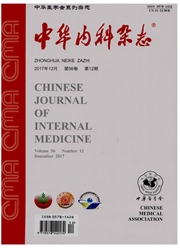

 中文摘要:
中文摘要:
目的 分析异基因造血干细胞移植(allo-HSCT)治疗伴有Fms样酪氨酸激酶3基因内部串联重复(FLT3-ITD)阳性的急性髓性白血病(AML)的疗效,探讨不同移植方式及疾病状态对该类患者预后的影响.方法 2006年10月至2012年10月在苏州大学附属第一医院行allo-HSCT的AML患者共314例,其中FLT3-ITD阳性54例,回顾性分析allo-HSCT对FLT3-ITD阳性AML患者的临床疗效.结果 54例FLT3-ITD阳性患者3年总生存(OS)率为56%,3年无白血病生存(LFS)率为47%.其中同胞人类白细胞抗原(HLA)全相合及亲缘HLA单倍型相合造血于细胞移植的患者3年OS率分别为56%和60%,3年LFS率为45%和54%.两组在OS时间及LFS时间方面的差异均元统计学意义(x2=0.074,P=0.786;x2=0.006,P=0.941).47例(87.0%)患者移植前本病处于首次完全缓解(CR1),7例(13.0%)患者移植前本病处于非CR1期.处于CR1期的患者的生存显著优于非CR1期患者.结论 allo-HSCT是FLT3-ITD阳性AML患者的有效治疗方法,亲缘HLA单倍型相合造血干细胞移植与同胞HLA全相合移植疗效相似.疾病复发是影响其疗效的主要因素.
 英文摘要:
英文摘要:
Objective To study the clinical outcome of patients with fns-like tyrosine kinase-3internal tandem duplication (FLT3-ITD) positive acute myeloid leukemia (AML) treated with allogeneic hematopoietic stem cell transplantation (allo-HSCT) and to explore the potential prognostic factors to patients' survival including transplant types or disease status.Methods A total of 314 AML patients in our center from October 2006 to October 2012 were retrospectively analyzed,among whom,54 patients were defined with FLT3-ITD positive.Survival rates and treatment-related mortality were further analyzed.Results For all 54 FLT3-ITD positive patients,the 3-year overall survival (3-OS) rate was 56% and 3-year leukemia-free survival (3-LFS) rate was 47%.The outcome of haplo-identical HSCT was similar as that of sibling donors(3-OS rate:60% vs 54% ; 3-LFS rate:54% vs 45%,respectively).There were 47 patients who received transplantation in first complete remission(CR1).The other 7 patients were of disease relapse or in CR2 before transplantation.Not surprisingly,patients in CR1 had better prognosis than those in nonCR1.Conclusions Allo-HSCT is an effective treatment for AML patients with FLT3-ITD positive mutation.The survival outcome of haplo-identical HSCT was comparable with that of sibling donors.Relapse of AML was the dominant factor related to the mortality of FLT3-ITD positive AML patients after allo-HSCT.
 同期刊论文项目
同期刊论文项目
 同项目期刊论文
同项目期刊论文
 期刊信息
期刊信息
